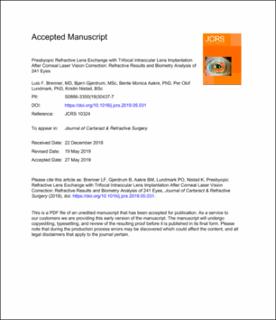| dc.contributor.author | Brenner, Louis | |
| dc.contributor.author | Gjerdrum, Bjørn | |
| dc.contributor.author | Aakre, Bente Monica | |
| dc.contributor.author | Lundmark, Per | |
| dc.contributor.author | Nistad, Kristin | |
| dc.date.accessioned | 2020-03-09T10:08:35Z | |
| dc.date.available | 2020-03-09T10:08:35Z | |
| dc.date.created | 2019-11-08T14:03:56Z | |
| dc.date.issued | 2019 | |
| dc.identifier.citation | Journal of cataract and refractive surgery. 2019, 45 (10), 1404-1015. | en_US |
| dc.identifier.issn | 0886-3350 | |
| dc.identifier.uri | https://hdl.handle.net/11250/2645964 | |
| dc.description | This is a PDF file of an unedited manuscript that has been accepted for publication. As a service to our customers we are providing this early version of the manuscript. The manuscript will undergo copyediting, typesetting, and review of the resulting proof before it is published in its final form. Please note that during the production process errors may be discovered which could affect the content, and all legal disclaimers that apply to the journal pertain. | en_US |
| dc.description.abstract | Purpose: To evaluate the refractive and biometry results of presbyopic refractive lens exchange (RLE) with trifocal intraocular lens (IOL) implantation in eyes with previous myopic or hyperopic corneal laser vision correction (LVC). Settings: Memira AS, Norway, Sweden, and Denmark. Design: Retrospective case series. Methods: The refractive results included the manifest refraction spherical equivalent, uncorrected near (UNVA) and distance (UDVA) visual acuities, corrected distance visual acuity, safety, efficacy, and precision. The biometry analysis included the refractive prediction error (RPE), median absolute error (MedAE), and percentage of eyes within a certain RPE range for the formulas from the American Society of Cataract and Refractive Surgery (ASCRS) online calculator. Results: The study comprised 241 eyes. Six months postoperatively, 60.0% of eyes were within G0.25 diopter (D), 80.9% within G0.50 D, and 97.9% within G1.00 D of emmetropia. There were no statistical differences in the mean monocular UDVA (0.87 G 0.20 [SD]), safety index (0.98 G 0.09), or efficacy index (0.81 G 0.18) between the myopic ablation group and hyperopic ablation group. Binocularly, 85% of patients had simultaneous UDVA and UNVA of 0.9 or better and Jaeger 3, respectively. The ASCRS online calculator formulas gave different performances for previous myopic and hyperopic ablation profiles. Using optimized constants and nomogram for correcting the mean RPE improved the MedAE. Conclusions: Presbyopic RLE was safe and effective in selected cases with a history of LVC. The use of optimized IOL constants and nomograms can improve the refractive precision of lensbased refractive surgery | en_US |
| dc.language.iso | eng | en_US |
| dc.rights | Attribution-NonCommercial-NoDerivatives 4.0 Internasjonal | * |
| dc.rights.uri | http://creativecommons.org/licenses/by-nc-nd/4.0/deed.no | * |
| dc.title | Presbyopic refractive lens exchange with trifocal intraocular lens implantation after corneal laser vision correction: Refractive results and biometry analysis | en_US |
| dc.type | Peer reviewed | en_US |
| dc.type | Journal article | en_US |
| dc.description.version | acceptedVersion | en_US |
| dc.source.pagenumber | 1404-1015 | en_US |
| dc.source.volume | 45 | en_US |
| dc.source.journal | Journal of cataract and refractive surgery | en_US |
| dc.source.issue | 10 | en_US |
| dc.identifier.doi | 10.1016/j.jcrs.2019.05.031 | |
| dc.identifier.cristin | 1745381 | |
| dc.relation.project | Norges forskningsråd: 273006 | en_US |
| cristin.unitcode | 222,56,2,0 | |
| cristin.unitname | Institutt for optometri, radiografi og lysdesign | |
| cristin.ispublished | true | |
| cristin.fulltext | original | |
| cristin.qualitycode | 1 | |

